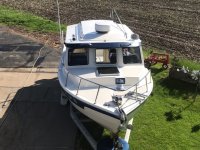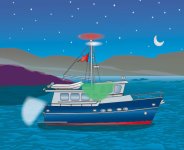clayhubler
Member
Several times since we've had Hammerhead we've either launched in the dark, or been out past dark. We have a spotlight on the roof, and I initially thought that would work great for motoring around at night. Problem is the glare that I get off the forward deck and bow rail. The spotlight is only good for looking around.
I've seen other boats with lights in the bow, below deck level. I've learned that these are called docking lights. I thought that would work great. I bought a set, this set:
https://www.westmarine.com/buy/aqua-sig ... fsQAvD_BwE
I then hooked them up to a battery at night and was not impressed.
So I looked around some more and bought these:
https://www.fisheriessupply.com/sierra- ... ghts/95001
I hooked them up and was very impressed. Problem is, the flange is too big. It will hang over the edge of the 'lapstrake'. Yes, I should have verified this when I ordered them, but these lights are honestly just way bigger than I thought.
So I am wondering what most of you use when motoring around at night? If anybody has lights on the bow or bow rail that you are very happy with please post a pic or a link. I like these 'docking lights' because I think they would look better than big lights mounted on the bow rail.
I am a little concerned that one may get broken years down the road and I will have cutouts in the hull and not be able to get a replacement, but I don't know what to do about that. Maybe 3D print a new housing...
I've seen other boats with lights in the bow, below deck level. I've learned that these are called docking lights. I thought that would work great. I bought a set, this set:
https://www.westmarine.com/buy/aqua-sig ... fsQAvD_BwE
I then hooked them up to a battery at night and was not impressed.
So I looked around some more and bought these:
https://www.fisheriessupply.com/sierra- ... ghts/95001
I hooked them up and was very impressed. Problem is, the flange is too big. It will hang over the edge of the 'lapstrake'. Yes, I should have verified this when I ordered them, but these lights are honestly just way bigger than I thought.
So I am wondering what most of you use when motoring around at night? If anybody has lights on the bow or bow rail that you are very happy with please post a pic or a link. I like these 'docking lights' because I think they would look better than big lights mounted on the bow rail.
I am a little concerned that one may get broken years down the road and I will have cutouts in the hull and not be able to get a replacement, but I don't know what to do about that. Maybe 3D print a new housing...




